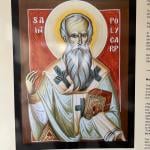We now turn slightly away from the discussions about a view of persons and the imago Dei.[1] This set of readings addresses the issue of God’s involvement in the creation processes, particularly in the works of Christopher Southgate and John Jefferson Davis.[2]

More than likely, most of my readers will lean one way or the other. The ones who I know personally will more than likely lean toward Biblical creationism, or even scientific creationism, as I do.
However, for one course I had to wade deep into the waters with Christian scientists who may hold a Biblical view to the best of their ability, and yet wrestle with ways to invite God to their workplace. They are reverent, while attempting to leave the door open for God to operate through secondary (evolutionary) means, if that is what God chooses.
On some points, I do not find very much common ground. On the other hand, I do not have an “us vs. them” mentality either. I have found that there are many good Christians in this field, and that there seems to be more than enough room for God at the table, when discussing creation and/or human origins.
Creationism and Theistic Evolution
Both Davis and Southgate explore the creation account, delineating a view of man created in God’s image, imago Dei. Likewise, both consider questions of science, physics, and quantum physics that open the door for dialogue about the existence of God.
In modern times, Southgate shares seven questions central to science and religion:
First, how important is science to a theology of creation? . . . Second, how does God act in the world? . . . Third, what is God’s relationship to time? . . . Fourth, what does the theology of creation mean for our care of the environment? . . . Fifth, how does the theology of creation relate to a theology of new creation? . . . Sixth, what is the importance of the Trinity for the theology of creation? . . . Seventh, what is the significance of human beings in creation?[3]
Although Southgate does not explore these questions in depth, he does offer a brief description of each and the significant strains of thought associated with them. At first, Southgate’s perspective seems to be heavily Theological. As the book progresses, he turns more to science, exploring theories, and pointing out ways that God can be invited to the table.
i. Anomalies
One of the ways Southgate opens the door for Theological discussion is by exploring anomalies. Early on he cites the example of the human eye. “How could one doubt that the human eye had been made to see with? Not until Darwin did that rhetorical question lose its force, and even Darwin confessed that he shivered whenever he thought of the eye.”[4]
Southgate eventually returns to anomalies, particularly in quantum mechanics, which are unexplainable by science. “By the early 1920’s then anomalies had grown into a gaping hole in the fabric of physics.”[5] Southgate reviews these anomalies and postulates that there might be a transcendent world observer, a divine mind, or a divine observer who is at work in these quantum processes.[6]
ii. Ultimate Observer
Both Southgate and Davis review the Anthropic Principles, Weak and Strong. Southgate reports on the proponents of the Strong Anthropic Principle (S.A.P.), who basically assume that something in the universe has allowed for life to develop, called the Ultimate Observer.
“Intelligent life-forms have cosmological significance by virtue of their future capacity to understand and manipulate matter on a cosmic scale.” In other words, scientifically speaking, this theory makes room for a Creator.[7] Davis explains the S.A.P., “The universe is governed by a teleological, life directed principle that ensures that the basic physical requirements of human life are met.”[8]
Another way that God is invited into the conversation is either through the theory of God as an Intelligent Designer or as a God of the Gaps. Southgate points out a number of ways the universe is so “fine-tuned” that any changes would be catastrophic. Whether one buys into the Biblical account of Creation or a form of the Big Bang, it is impossible to conceive of the world coming into existence without Divine aid. Davis explores the Weak Anthropic Principle (W.A.P.) at length and ties Intelligent Design into it.
Davis explains the “Theory of Everything” that scientists are searching for. Apparently, if everything can be explained, then there is no need for a transcendent being. In response, physicist James Trefil simply asks, “Who made the laws of logic? . . . there will always be room for religious faith and for a religious interpretation of the physical world.”[9]
iii. Creationism and Theistic Evolution
In conclusion, both Southgate and Davis develop a strong theological understanding, particularly of man as one created in the image of God, imago Dei.
Both espouse free will over determinism and predestination.
Both openly explore metaphysical questions in light of modern science.
As far as integration, Southgate develops a strong Theology, then shifts to views of science that merely make room for the question of God. On a couple of occasions, Davis does not use science to explain Theology, but as a means of illustrating it.
Both Southgate and Davis suggest types of Theistic evolution, i.e. God used secondary processes to create life and allow it to evolve.
It is disheartening that scientific creationism is not even explored.
notes:
[1] Other articles in this series so far:Toward a Biblical Concept of Personality
On Holism, Holiness, and Wholeness
The Image, the Body, and Renewal
On the Mystery of Spirit and Salvation
External Factors of Personality
Developing a Biblical View of Persons
The Human Person: the imago Dei and biotechnology
[2] Jared V. Ingle, “God and Physics: Exploring the Thought of Christopher Southgate and John Jefferson Davis” (paper presented in, The Human Person: Multi-Disciplinary Perspectives, Asbury Theological Seminary, March 6, 2011). [3] Christopher Southgate, God, Humanity and the Cosmos (New York: T & T Clark International, 2005), 57-60.Amazon: God, Humanity and the Cosmos
Amazon: The Frontiers of Science and Faith













